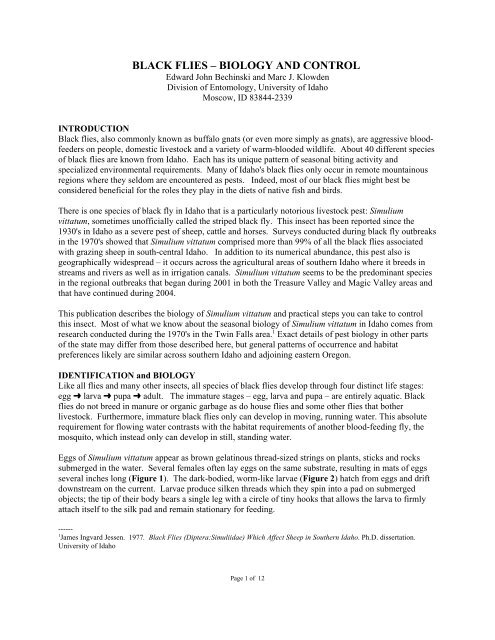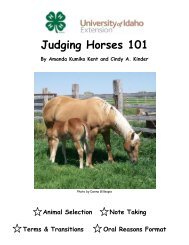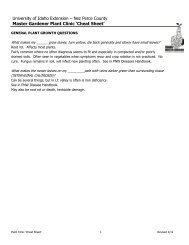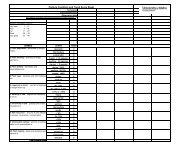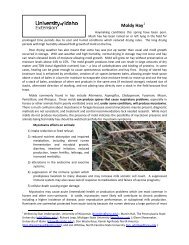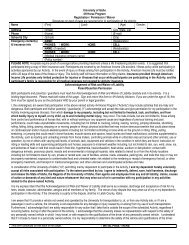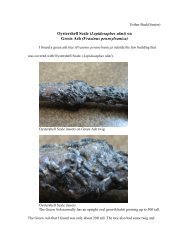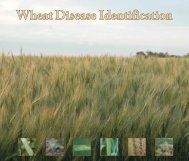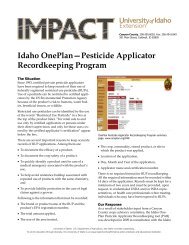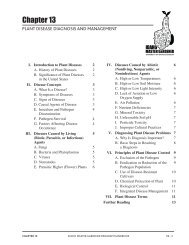Black Flies - Biology and Control - University of Idaho Extension (Ver ...
Black Flies - Biology and Control - University of Idaho Extension (Ver ...
Black Flies - Biology and Control - University of Idaho Extension (Ver ...
You also want an ePaper? Increase the reach of your titles
YUMPU automatically turns print PDFs into web optimized ePapers that Google loves.
BLACK FLIES – BIOLOGY AND CONTROL<br />
Edward John Bechinski <strong>and</strong> Marc J. Klowden<br />
Division <strong>of</strong> Entomology, <strong>University</strong> <strong>of</strong> <strong>Idaho</strong><br />
Moscow, ID 83844-2339<br />
INTRODUCTION<br />
<strong>Black</strong> flies, also commonly known as buffalo gnats (or even more simply as gnats), are aggressive bloodfeeders<br />
on people, domestic livestock <strong>and</strong> a variety <strong>of</strong> warm-blooded wildlife. About 40 different species<br />
<strong>of</strong> black flies are known from <strong>Idaho</strong>. Each has its unique pattern <strong>of</strong> seasonal biting activity <strong>and</strong><br />
specialized environmental requirements. Many <strong>of</strong> <strong>Idaho</strong>'s black flies only occur in remote mountainous<br />
regions where they seldom are encountered as pests. Indeed, most <strong>of</strong> our black flies might best be<br />
considered beneficial for the roles they play in the diets <strong>of</strong> native fish <strong>and</strong> birds.<br />
There is one species <strong>of</strong> black fly in <strong>Idaho</strong> that is a particularly notorious livestock pest: Simulium<br />
vittatum, sometimes un<strong>of</strong>ficially called the striped black fly. This insect has been reported since the<br />
1930's in <strong>Idaho</strong> as a severe pest <strong>of</strong> sheep, cattle <strong>and</strong> horses. Surveys conducted during black fly outbreaks<br />
in the 1970's showed that Simulium vittatum comprised more than 99% <strong>of</strong> all the black flies associated<br />
with grazing sheep in south-central <strong>Idaho</strong>. In addition to its numerical abundance, this pest also is<br />
geographically widespread – it occurs across the agricultural areas <strong>of</strong> southern <strong>Idaho</strong> where it breeds in<br />
streams <strong>and</strong> rivers as well as in irrigation canals. Simulium vittatum seems to be the predominant species<br />
in the regional outbreaks that began during 2001 in both the Treasure Valley <strong>and</strong> Magic Valley areas <strong>and</strong><br />
that have continued during 2004.<br />
This publication describes the biology <strong>of</strong> Simulium vittatum <strong>and</strong> practical steps you can take to control<br />
this insect. Most <strong>of</strong> what we know about the seasonal biology <strong>of</strong> Simulium vittatum in <strong>Idaho</strong> comes from<br />
research conducted during the 1970's in the Twin Falls area. 1 Exact details <strong>of</strong> pest biology in other parts<br />
<strong>of</strong> the state may differ from those described here, but general patterns <strong>of</strong> occurrence <strong>and</strong> habitat<br />
preferences likely are similar across southern <strong>Idaho</strong> <strong>and</strong> adjoining eastern Oregon.<br />
IDENTIFICATION <strong>and</strong> BIOLOGY<br />
Like all flies <strong>and</strong> many other insects, all species <strong>of</strong> black flies develop through four distinct life stages:<br />
egg º larva º pupa º adult. The immature stages – egg, larva <strong>and</strong> pupa – are entirely aquatic. <strong>Black</strong><br />
flies do not breed in manure or organic garbage as do house flies <strong>and</strong> some other flies that bother<br />
livestock. Furthermore, immature black flies only can develop in moving, running water. This absolute<br />
requirement for flowing water contrasts with the habitat requirements <strong>of</strong> another blood-feeding fly, the<br />
mosquito, which instead only can develop in still, st<strong>and</strong>ing water.<br />
Eggs <strong>of</strong> Simulium vittatum appear as brown gelatinous thread-sized strings on plants, sticks <strong>and</strong> rocks<br />
submerged in the water. Several females <strong>of</strong>ten lay eggs on the same substrate, resulting in mats <strong>of</strong> eggs<br />
several inches long (Figure 1). The dark-bodied, worm-like larvae (Figure 2) hatch from eggs <strong>and</strong> drift<br />
downstream on the current. Larvae produce silken threads which they spin into a pad on submerged<br />
objects; the tip <strong>of</strong> their body bears a single leg with a circle <strong>of</strong> tiny hooks that allows the larva to firmly<br />
attach itself to the silk pad <strong>and</strong> remain stationary for feeding.<br />
------<br />
1 James Ingvard Jessen. 1977. <strong>Black</strong> <strong>Flies</strong> (Diptera:Simuliidae) Which Affect Sheep in Southern <strong>Idaho</strong>. Ph.D. dissertation.<br />
<strong>University</strong> <strong>of</strong> <strong>Idaho</strong><br />
Page 1 <strong>of</strong> 12
Figure 1. <strong>Black</strong> fly egg masses with other<br />
immature life stages on aquatic plants.<br />
Figure 2. <strong>Black</strong> fly larva showing filter-feeding<br />
fans on head <strong>and</strong> bulbous posterior body<br />
segments; mature body size is 2/10-inches.<br />
Larvae feed by means <strong>of</strong> two small comb-like fans that filter algae, bacteria <strong>and</strong> fine particles <strong>of</strong> leaf<br />
debris or other organic matter suspended in the water. Larvae normally remain attached to submerged<br />
objects but can drift downstream several inches on silken threads if their habitat is disturbed. Long<br />
distance drift sometimes results in dramatic week-to-week changes in larval populations. Larvae molt<br />
(shed their skins) 7 to 11 times, each time growing to a larger body size. Full-grown larvae are<br />
approximately 2/10th-inches long.<br />
Mature larvae molt into a pupa (Figure 3), a non-feeding, non-mobile transitional stage during which the<br />
insect develops the body features <strong>of</strong> the adult fly. The pupa itself is enclosed within a slipper-shaped<br />
brownish silken cocoon that remains attached to the substrate under the water. Pupae breathe by means <strong>of</strong><br />
a pair <strong>of</strong> distinctively shaped tubular, branched gills that project forward from the head. Both the larval<br />
<strong>and</strong> pupal stages <strong>of</strong> Simulium vittatum <strong>of</strong>ten anchor themselves to submerged aquatic plants or on<br />
bank-side grasses <strong>and</strong> weeds that trail their leaves into the water. Pondweed (Potamageton pectinatus) in<br />
irrigation canals sometimes is completely covered with black fly larvae <strong>and</strong> pupae (Figure 4).<br />
Figure 3. <strong>Black</strong> fly pupa within slipper-shaped<br />
silk cocoon; tubular, finger-like gills project<br />
forward from head.<br />
Figure 4. <strong>Black</strong> fly larvae <strong>and</strong> pupae sometimes<br />
nearly cover aquatic plants.<br />
PHOTO CREDIT: Marni Porath <strong>and</strong> Kimberly<br />
Wallin, Oregon State <strong>University</strong><br />
Page 2 <strong>of</strong> 12
After several days to a few weeks, depending on water temperature, the pupa molts to the adult stage.<br />
The fly rises through the water inside an air bubble that breaks the surface <strong>and</strong> allows the adult to escape<br />
to a resting site on vegetation at the margins <strong>of</strong> the water where their wings exp<strong>and</strong> to full size <strong>and</strong> their<br />
bodies harden. Once they reach the adult stage, black flies do not grow to a larger body size.<br />
Simulium vittatum adults are about 1/16-inch long, generally dark grey-to-black, with a distinctive<br />
hump-backed appearance when viewed in pr<strong>of</strong>ile (Figure 5). In spite <strong>of</strong> their common name, certain<br />
other species <strong>of</strong> <strong>Idaho</strong> black flies (especially in the genus Prosimulium) are orange-to-tan colored rather<br />
than black. The hump-backed thorax <strong>of</strong> Simulium vittatum is marked on the top with 3 thin dark stripes,<br />
but this feature is not unique to this species. Definitive identification to species only can be made by<br />
expert technical examination.<br />
Under magnification, a pair <strong>of</strong> short, pointed antennae can be seen projecting forward from the head <strong>of</strong><br />
adult black flies. The mouthparts <strong>of</strong> female are prolonged into a stout, downward-pointing, knife-like<br />
blade that pierces the skin <strong>of</strong> their host animal (Figure 6). Male black flies have two large prominent<br />
eyes that meet together at the front <strong>of</strong> the face, while females have smaller eyes that are separated at the<br />
front <strong>of</strong> the face.<br />
Figure 5. Adult black fly showing characteristic<br />
stout-bodied, hump-backed appearance.<br />
Figure 6. <strong>Black</strong> flies feed by piercing the host’s<br />
skin with knife-like mouthparts; in this specimen<br />
the abdomen is swollen with ingested blood.<br />
SEASONAL LIFE CYCLE<br />
Partially mature larvae are the sole overwintering stage <strong>of</strong> Simulium vittatum in <strong>Idaho</strong>. Larvae primarily<br />
survive the winter in natural flowing waters ranging in size from small upl<strong>and</strong> streams to wide rivers,<br />
including the Snake River. Larvae also can survive in irrigation canals that have permanent water flows<br />
during the winter months. This insect does not overwinter as any life stage in canals that run dry after the<br />
cropping season, nor can it survive the winter in still, pooled water that remains in canals.<br />
Larvae cannot survive freezing but can develop in water that flows under ice during the winter. They<br />
slowly develop through the winter <strong>and</strong> spring months to the pupal stage <strong>and</strong> emerge as adult flies during<br />
early-to-mid April. Some female flies continue local breeding cycles in streams <strong>and</strong> rivers; others<br />
disperse during late April <strong>and</strong> early May to nearby irrigation canals. Female flies crawl down plants <strong>and</strong><br />
lay up to 600 eggs. This initial spring period <strong>of</strong> egg laying occurs without any blood-feeding by the<br />
female fly; egg-laying during later generations typically only can occur after the female fly ingests a<br />
blood meal.<br />
Page 3 <strong>of</strong> 12
Larvae <strong>and</strong> pupae <strong>of</strong> this first summer generation are present in rivers <strong>and</strong> canals through late May to<br />
early June, with new adults emerging from canals during mid June <strong>and</strong> beginning another egg-laying<br />
cycle. Adults live about 1-month.<br />
Egg-to-adult development requires 3-to-4 weeks under typical summer conditions. The exact time<br />
required for development mainly depends on water temperature. Development is slowest (longest) when<br />
water temperature is cold <strong>and</strong> is fastest when water temperature is warm; development is twice as fast<br />
during the summer when canal water temperature is 75
– biting behavior<br />
Adult female black flies are the only ones that feed on blood <strong>and</strong> so are the only pestiferous stage. Both<br />
males <strong>and</strong> females <strong>of</strong> Simulium vittatum feed on the nectar <strong>of</strong> flowers, including alfalfa <strong>and</strong> smallflowered<br />
weedy plants. Males only feed on nectar <strong>and</strong> therefore are never pests.<br />
Females only feed on the blood <strong>of</strong> mammals (i.e., warm-blooded vertebrates). They locate potential hosts<br />
by flying upwind toward increasing concentrations <strong>of</strong> carbon dioxide that animals produce on their breath<br />
<strong>and</strong> from their skin. Differences among individuals in amounts <strong>of</strong> carbon dioxide produced explain why<br />
black flies (as well as mosquitoes <strong>and</strong> other blood-feeding flies <strong>and</strong> gnats) are attracted to some people<br />
more than others.<br />
At closer ranges, black flies also depend on vision to locate potential hosts. Mating swarms <strong>of</strong> gnats <strong>of</strong>ten<br />
congregate over visual markers (such as a tree or rock), including animal <strong>and</strong> human hosts which they<br />
sometimes follow for hundreds <strong>of</strong> feet. Females tend to be attracted to dark-colored (blue <strong>and</strong> black)<br />
silhouettes. Yellow-green objects are attractive to egg-laying female flies. This color preference can be<br />
used to monitor egg-laying activity by floating lengths <strong>of</strong> yellow-colored rope in canals <strong>and</strong> streams as<br />
artificial egg-laying sites (Figure 7).<br />
Figure 7. <strong>Black</strong> fly egg laying can be monitored by floating lengths <strong>of</strong> yellow-colored rope in flowing<br />
waters where larvae breed. Image on right shows rope glistening with black fly eggs <strong>and</strong> larvae 1-week<br />
after placement in an irrigation canal.<br />
Like many other species <strong>of</strong> black flies, Simulium vittatum has definite daily biting activity periods.<br />
Under sunny summer skies, gnats are most active in the morning <strong>and</strong> again during the evening; biting<br />
activity generally is highest between 7 to 10 a.m. <strong>and</strong> again at 4 to 7 p.m. Under cloudy, cooler<br />
conditions, biting may occur throughout the day with peaks during early afternoon. Air temperature<br />
below 50
– host range <strong>and</strong> injury<br />
Simulium vittatum only rarely bites humans, but when it does, the bite can be quite painful. Individual<br />
reaction to bites results from the body's allergic response to the saliva that the female injects as she feeds.<br />
Her saliva contains anti-clotting agents that allow the fly to feed more easily. The bite itself appears as a<br />
raised pinkish welt with a red-purple spot in the center. Many people experience itching that lasts for<br />
several days after a bite, but severe allergic reactions such as asthma also have been reported. Bites <strong>of</strong><br />
some <strong>Idaho</strong> black flies sometime result in a syndrome called “black fly fever” with symptoms that include<br />
headache, fever, nausea <strong>and</strong> large swellings around the neck. Unlike mosquitoes, none <strong>of</strong> our North<br />
American black flies transmit disease-causing pathogens to humans. In the tropics <strong>of</strong> Central <strong>and</strong> South<br />
America <strong>and</strong> Africa, other species <strong>of</strong> black flies transmit parasites that cause river blindness in humans.<br />
Even though Simulium vittatum is almost exclusively a biting pest <strong>of</strong> livestock <strong>and</strong> not people, it still can<br />
be an intolerable nuisance to anyone working or playing outdoors. <strong>Black</strong> flies have the maddening habit<br />
<strong>of</strong> flying around the face <strong>and</strong> crawling through the scalp or into eyes <strong>and</strong> ears <strong>and</strong> under open shirt<br />
collars. Swarming, crawling gnats around the head can be as irritating as the bite itself.<br />
Simulium vittatum mainly feeds on the blood <strong>of</strong> sheep, cattle, horses <strong>and</strong> mules, especially where body<br />
hair is sparse <strong>and</strong> skin is thin such as around the eyes <strong>and</strong> nose, inside the ears, <strong>and</strong> along the belly.<br />
Repeated feeding on the ears <strong>of</strong> horses can result in secondary infections <strong>and</strong> scabby, swollen<br />
granulations that sometimes require surgical removal (Figure 8). Poultry (chickens, ducks <strong>and</strong> geese,<br />
turkeys) <strong>and</strong> hogs are less frequent hosts <strong>of</strong> Simulium vittatum.<br />
Figure 8. Simulium vittatum especially feeds<br />
inside the ears <strong>of</strong> horses; here the ear has been<br />
folded back to show the scabby tissues typical <strong>of</strong><br />
black fly feeding.<br />
Figure 9. Sheep respond to black fly attack by<br />
by bunching together low on the ground <strong>and</strong><br />
refusing to graze.<br />
Extreme black fly attack can kill livestock either from toxic shock reactions to the fly’s saliva or accidents<br />
when animals try to escape fly attack. Calves can be physically suffocated if massive numbers <strong>of</strong> gnats<br />
crawl into the respiratory system. Overall, animal deaths are rare. Economic losses to ranchers <strong>and</strong> dairy<br />
operators instead usually occur as reductions in animal weight or milk production caused when fly attack<br />
makes it difficult for animals to feed.<br />
Livestock attempt to escape attack by bunching up together <strong>and</strong> refusing to graze. B<strong>and</strong>s <strong>of</strong> sheep <strong>of</strong>ten<br />
st<strong>and</strong> in tight groups with their heads down, exposing only their backs <strong>and</strong> refusing to graze; individual<br />
animals lay prone with their heads <strong>and</strong> ears flat on the ground (Figure 9). Cattle <strong>and</strong> horses similarly<br />
Page 6 <strong>of</strong> 12
unch together, constantly flicking their ears <strong>and</strong> kicking up dust. Animals sometimes stay under trees<br />
<strong>and</strong> bushes rather than grazing in the open where fly attack is most severe. The concentrated trampling <strong>of</strong><br />
pasture <strong>and</strong> rangel<strong>and</strong> vegetation can be severe.<br />
The stress <strong>of</strong> black fly attack also can increase an animal’s susceptibility to pneumonia or other stressrelated<br />
respiratory diseases. Simulium vittatum apparently can transmit the virus that causes vesicular<br />
stomatitis in livestock, though its exact importance in virus transmission is not known.<br />
BLACK FLY CONTROL<br />
Adult black flies readily disperse several miles from their larval breeding habitats <strong>and</strong> so continuously<br />
invade pastures, feedlots <strong>and</strong> other livestock areas as well as residential backyards distantly located from<br />
breeding sources. This means that long-term relief from ultimately depends on reducing larval<br />
populations where they breed – in streams, rivers, irrigation canals <strong>and</strong> other running waters. But in the<br />
short term, there are some practical steps you can take against adult black flies.<br />
– protecting yourself from adult black flies<br />
You can reduce but not eliminate personal harassment from swarming black flies when working outside<br />
around the farm or home by adopting a three-step CAR approach: Confuse, Avoid <strong>and</strong> Repel.<br />
Confuse black flies by wearing light-colored clothing –<br />
Dark colors are more attractive to adult black flies than light colors; especially avoid dark blue<br />
clothing because it is particularly attractive.<br />
Avoid outdoor activities when black flies are most active –<br />
Simulium vittatum is most active for a few hours after sunrise <strong>and</strong> again during the early evening a<br />
few hours before sunset. If you must be outside during these times, consider wearing hats that cover<br />
the ears (or fine-veiled head nets) <strong>and</strong> tight-fitting long-sleeved shirts without buttons so as to<br />
minimize numbers <strong>of</strong> gnats that otherwise might crawl into the ears <strong>and</strong> under shirt collars or through<br />
button-holes. <strong>Black</strong> flies do not bite through clothing, so cover exposed skin as much as practical.<br />
Repel black flies by using insect repellents that contain DEET –<br />
The synthetic chemical N,N-diethyl-3-methylbenzamide (formerly N,N-diethyl-m-toluamide), more<br />
simply called DEET, can protect you <strong>and</strong> your family from black fly attack as well as from ticks,<br />
fleas, mosquitoes <strong>and</strong> other biting flies. Products are sold in <strong>Idaho</strong> under more than 100 different<br />
br<strong>and</strong> names (such as Cutter, Off!, Sawyer <strong>and</strong> Ultrathon), but regardless <strong>of</strong> br<strong>and</strong> name, each product<br />
always lists on the label the active ingredient as DEET or N,N-diethyl-3-methylbenzamide or<br />
N,N-diethyl-m-toluamide.<br />
Although DEET is called a repellent, it actually seems to interfere with the insect’s ability to<br />
recognize us as potential hosts. Commercially available sprays <strong>and</strong> lotions range from 5% to 100%<br />
DEET. The more concentrated products do not provide higher levels <strong>of</strong> protection but instead simply<br />
last longer on the skin or clothes than less concentrated products. In general, 30 to 50% DEET is<br />
adequate for adults.<br />
Guidelines established by the American Academy <strong>of</strong> Pediatrics recommend a conservative approach<br />
to using DEET repellents on children. Do not use products containing more than 10% DEET on<br />
children. Adults always should apply DEET to children, avoiding the eyes, mouth <strong>and</strong> nose as well<br />
as skin covered by clothing. DEET products are NOT RECOMMENDED for infants less than 2<br />
years old.<br />
Page 7 <strong>of</strong> 12
Never use DEET products on pets, horses or on livestock animals because they will ingest the<br />
chemical when they groom themselves.<br />
Natural alternatives to DEET are available <strong>and</strong> include plant oils (cedarwood, citronella, eucalyptus)<br />
<strong>and</strong> IR3535 (technically known as 3-[N-butyl-N-acetyl]-aminopropionic acid, ethyl ester), a chemical<br />
related to an essential naturally occurring amino acid. Table 1 lists the names <strong>of</strong> products available<br />
in <strong>Idaho</strong>. Tests with mosquitoes have shown that the plant oil products provide lesser protection than<br />
DEET; it is safe to assume that they are similarly less effective than DEET against black flies.<br />
TABLE 1. Alternatives to DEET for black fly repellents in <strong>Idaho</strong><br />
trade name % active ingredient manufacturer signal words<br />
products that contain IR3535<br />
SKIN-SO-SOFT Bug Guard PLUS IR3535 Insect Repellent Moisturizing Sunblock Lotion SPF 30 7.5% Avon Products caution<br />
SKIN-SO-SOFT Bug Guard PLUS IR3535 Expedition Insect Repellent Aerosol 20.1% Avon Products warning<br />
SKIN-SO-SOFT Bug Guard PLUS IR3535 Insect Repellent Moisturizing Lotion 7.5% Avon Products caution<br />
SKIN-SO-SOFT Bug Guard PLUS IR3535 Insect Repellent Spray 7.5% Avon Products caution<br />
Bug Guard Plus IR3535 Active Insect Repellent Gentle Breeze Towelettes 7.5% Avon Products warning<br />
products that contain cedarwood oil <strong>and</strong> oil <strong>of</strong> citronella<br />
BUG BLOCK SUNSCREEN AND INSECT REPELLENT 0.5% <strong>and</strong> 4.2% W F Young Inc caution<br />
products that contain oil <strong>of</strong> eucalyptus<br />
REPEL LEMON EUCALYPTUS INSECT REPELLENT LOTION 30% WPC Br<strong>and</strong>s warning<br />
REPEL LEMON EUCALYPTUS INSECT REPELLENT SPRAY LOTION 30% WPC Br<strong>and</strong>s warning<br />
SURVIVOR LEMON EUCALYPTUS INSECT REPELLENT 30% WPC Br<strong>and</strong>s warning<br />
REPEL PLANT BASED LEMON EUCALYPTUS INSECT REPELLENT 40% WPC Br<strong>and</strong>s caution<br />
products that contain p-Menthane-3,8-diol<br />
OFF! BOTANICALS TOWELETTES 8% SC Johnson & Son caution<br />
OFF! BOTANICALS INSECT REPELLENT 10% SC Johnson & Son caution<br />
TABLE NOTES:<br />
(1) Signal words designate the relative risk a pesticide will cause harmful health effects on humans, where caution = slightly toxic, warning = moderately<br />
toxic, <strong>and</strong> danger = most toxic. The U.S. Environmental Protection Agency (EPA) considers all products listed here to pose little acute risks to human<br />
health except for possible eye irritation.<br />
(2) Avon product line includes additional IR3535 repellents not listed here that differ with respect to fragrance <strong>and</strong>/or sunscreen content.<br />
(3) p-Menthane-3,8-diol naturally occurs in the leaves <strong>and</strong> twigs <strong>of</strong> the lemon eucalyptus plant but is chemically synthesized for commercial use.<br />
Electronic devices that claim to repel insect by emitting ultrasonic sounds or electromagnetic signals have<br />
no value for alleviating black fly nuisance. More than 25-years <strong>of</strong> scientific research has shown that these<br />
devices do not repel any insect. Potentially more useful are the backyard mosquito traps (eg., Mosquito<br />
Magnet <strong>and</strong> many other br<strong>and</strong>s) that emit plumes <strong>of</strong> carbon dioxide <strong>and</strong> other attractants. These devices<br />
really do lure <strong>and</strong> kill mosquitoes <strong>and</strong> so likely attract <strong>and</strong> trap black flies too, but it remains to be seen if<br />
these devices trap enough insects to reduce pests to tolerable levels.<br />
Insecticides can be applied as aerosol fogs or as light mists in backyard areas to kill black flies as they rest<br />
on plants <strong>and</strong> buildings. However, except for the most extreme black fly infestations, we recommend<br />
against such applications. At best, backyard premise sprays only provide temporary relief that lasts no<br />
more than a few days. <strong>Flies</strong> that arrive after insecticides evaporate will not be killed. Further, the<br />
Page 8 <strong>of</strong> 12
available insecticides are not specific in their killing action to black flies. Products instead also kill lady<br />
beetles <strong>and</strong> other natural enemies that help keep plant-feeding pests in check. These insecticides also are<br />
lethal to honeybees <strong>and</strong> other pollinators necessary to set fruits <strong>and</strong> vegetables.<br />
If you do decide to spray backyard vegetation, be sure the label says the insecticide can be applied to your<br />
specific plants <strong>and</strong> that it additionally says it kills adult black flies or adult mosquitoes. If you are<br />
making applications around vegetable gardens, fruit trees <strong>and</strong> other plants that bear edible produce, it is<br />
especially critical to make sure that your crops specifically are listed on the insecticide label. If not, you<br />
have the wrong product <strong>and</strong> could inadvertently poison yourself or your family.<br />
– protecting livestock from adult flies<br />
insecticides<br />
Numerous commercially available insecticides can be used in <strong>Idaho</strong> for application either directly to<br />
livestock animals or as premise sprays in or around livestock buildings to kill adult black flies. Lists <strong>of</strong><br />
approved products for beef <strong>and</strong> dairy cattle, horses, sheep, goats <strong>and</strong> hogs are posted at website <strong>of</strong> the<br />
<strong>University</strong> <strong>of</strong> <strong>Idaho</strong> Pest Management Center,<br />
http://agweb.ag.uidaho.edu/ipm/<br />
Insecticides by themselves only can provide livestock with short-term biting relief from adult black flies.<br />
All <strong>of</strong> the available products have relatively short residual killing action – they only last for several days –<br />
<strong>and</strong> so must be applied repeatedly during the biting season at time intervals as permitted by the pesticide<br />
label.<br />
alternatives to insecticides<br />
Although black flies are highly mobile, biting intensity usually is greatest next to irrigation canals <strong>and</strong><br />
streams or rivers where the larval stages <strong>of</strong> this pest live. Pasture your animals as far away from these<br />
pest sources as practical.<br />
Unlike mosquitoes, black flies generally do not enter buildings or other enclosed, darkened spaces.<br />
Simply-constructed shelters consisting <strong>of</strong> three solid walls <strong>and</strong> a ro<strong>of</strong> can provide cattle, horses <strong>and</strong> sheep<br />
with refuge from biting attack in pastures <strong>and</strong> rangel<strong>and</strong>s. <strong>Black</strong> fly control for beef <strong>and</strong> dairy cattle can<br />
be enhanced by placing insecticide-charged back rubbers at the entrance to shelters. When practical, keep<br />
your animals inside barns during the morning <strong>and</strong> early evening hours when biting tends to be heaviest.<br />
<strong>Black</strong> flies especially buzz around the heads <strong>of</strong> horses <strong>and</strong> feed near the ears. Petroleum jelly smeared<br />
around the ears <strong>and</strong> head creates a physical barrier that black flies cannot penetrate. Commercially<br />
available “fly-mask” mesh nets that fit over the head <strong>and</strong> ears <strong>of</strong> the horse similarly exclude black flies.<br />
Finally, as noted previously, it is illegal to use DEET products on pets, horses or livestock animals.<br />
Grooming animals will ingest the chemical <strong>and</strong> may become sickened.<br />
– area-wide approaches to larval management<br />
Successful larval control requires coordinated region-wide pest management action across the broadest<br />
possible geographic range <strong>of</strong> larval habitat <strong>and</strong> so is beyond the capability <strong>of</strong> an individual l<strong>and</strong>owner to<br />
accomplish alone. No single method <strong>of</strong> larval control by itself can provide satisfactory reductions in fly<br />
attack. Area-wide management instead depends on bringing together several different control methods<br />
into an overall pest management program.<br />
Page 9 <strong>of</strong> 12
natural enemies<br />
Numerous fish <strong>and</strong> birds (such as trout <strong>and</strong> ducks) feed on the adult <strong>and</strong> larval stages <strong>of</strong> black flies, but<br />
little if anything can be done to practically manipulate populations <strong>of</strong> these natural predators in ways that<br />
enhance their impact. In areas where they are abundant, black flies can be critical part <strong>of</strong> the diet <strong>of</strong> fish<br />
<strong>and</strong> birds. Hence, pest control programs for black flies can have unintended harmful impacts on<br />
ecosystems.<br />
A more promising natural enemy is a tiny parasitic nematode, Gastromermis viridis [Mermithidae],<br />
known from prior surveys in the irrigation canals <strong>of</strong> south-central <strong>Idaho</strong>. This roundworm penetrates the<br />
body wall <strong>of</strong> larval black flies where it feeds internally, eventually growing so large that it entirely fills<br />
the internal body cavity <strong>of</strong> the black fly (Figure 10). The parasite kills the black fly when the juvenile<br />
worm exits from the larva. In other regions <strong>of</strong> the US, worms can persist into the pupal <strong>and</strong> adult stages<br />
<strong>of</strong> the black fly before killing their host.<br />
Figure 10. <strong>Black</strong> fly larval cadaver (dark, thicker<br />
body form at top <strong>of</strong> photo) following emergence <strong>of</strong><br />
parasitic nematode (thin, long coiled worm at bottom<br />
<strong>of</strong> photo).<br />
In the Twin Falls area where they were studied, nematode-infected black fly larvae usually were first<br />
detected in canals during the initial June generation. Parasitism increased through the season <strong>and</strong><br />
reached larval kill rates <strong>of</strong> nearly 100% at some sites during August <strong>and</strong> September. The highest attack<br />
rates were at the downstream parts <strong>of</strong> canals most distantly located from reservoir outlets. In spite <strong>of</strong><br />
these extreme larval kill rates, adult fly populations never declined below levels pestiferous to sheep.<br />
Much more research will be required before we can directly use nematodes to control black flies. This<br />
worm is not available commercially for mass-release into canals.<br />
habitat management<br />
Because black flies require running waters for egg-to-pupal development, immature black flies can be<br />
killed by manipulating water flows. For example, water levels in irrigation canals could be raised <strong>and</strong><br />
lowered at regular intervals during the summer so as to str<strong>and</strong> black fly eggs, larvae <strong>and</strong> pupae on<br />
vegetation above the water line. Alternatively, water could be impounded into still, non-flowing pools<br />
between canal gates; several consecutive days <strong>of</strong> interrupted flow would be required because larvae <strong>of</strong><br />
Simulium vittatum can survive (but not complete development) a few days in still, stagnant water. Even<br />
more extreme, water flow into canals temporarily could be stopped <strong>and</strong> the system allowed to run<br />
completely dry, thereby totally eradicating the immature pest population.<br />
Page 10 <strong>of</strong> 12
Pragmatic need for dependable flows <strong>of</strong> irrigation water throughout the cropping season makes any <strong>of</strong><br />
these manipulations difficult if not outright impossible. Even if it was possible to alter water flows, the<br />
effect on black fly larvae <strong>and</strong> pupae would be dramatic but temporary. Adult flies that had previously<br />
emerged would recolonize the canal by laying more eggs when flow returned to normal; further, these<br />
pre-existing adult flies still would be present over the short term as pests.<br />
Another approach to habitat manipulation that is compatible with efficient delivery <strong>of</strong> irrigation water is<br />
weed control – to eliminate the aquatic plants where larvae <strong>and</strong> pupae anchor themselves – by either<br />
treating irrigation canals with chemical herbicides or by mechanical removing submerged <strong>and</strong> floating<br />
plants. Studies in the Twin Falls canal system during the 1970's suggested that the herbicide acrolein<br />
(sold under the trade name Magnacide H) not only kills aquatic weeds but also is directly toxic to<br />
Simulium vittatum by interfering with larval muscle control. Larvae disappeared from canals treated with<br />
acrolein the day following herbicide application; pupae were not affected by herbicide treatment <strong>and</strong><br />
completed development to adult flies. Early-season weed control particularly might provide relief by<br />
reducing numbers <strong>of</strong> fly generations later during the year.<br />
larval insecticides<br />
The only insecticides that legally may be applied to waters in <strong>Idaho</strong> for black fly control are those that<br />
contain the active ingredient Bacillus thuringiensis israelensis, or Bti for short. Bti is a bacterium that<br />
produces a toxin that only is lethal to the larval stages <strong>of</strong> black flies, mosquitoes, fungus gnats <strong>and</strong> related<br />
flies. Bti essentially is harmless to fish, birds, <strong>and</strong> people; the only organisms it kills are the larval stages<br />
<strong>of</strong> a few related types <strong>of</strong> flies.<br />
Bti insecticides do not contain living bacterial cells but instead consist <strong>of</strong> the toxic crystalline protein<br />
naturally produced by Bacillus thuringiensis israelensis. The formulated insecticide is applied directly to<br />
the water (Figure 11) where the filter-feeding black fly larvae ingest the suspended toxic crystals. The<br />
toxin must be eaten by the larvae to be effective; it has no killing action by external contact with black fly<br />
eggs, larvae, pupae or adults. Application timing is critical because Bti is most effective against the<br />
smallest (youngest) larvae. Larvae sometimes die within 30-minutes <strong>of</strong> ingesting a lethal dose or they<br />
may linger a day or two.<br />
Figure 11. Commercial application <strong>of</strong> Bacillus thuringiensis israelensis insecticide into an irrigation<br />
canal for larval black fly control.<br />
Page 11 <strong>of</strong> 12
Bti products do not produce self-generating infections because no living bacterium is present to recycle<br />
itself in the environment. As soon as the toxic crystals dissipate on water currents, potential larval killing<br />
action immediately ends. Any new larvae hatching from eggs will not be killed. A single Bti application<br />
has no immediate impact on pre-existing gnat nuisance problems because Bti only kills the larval stages.<br />
Regionally coordinated, repeated Bti applications are required to reduce pest populations because adult<br />
black flies continually repopulate the habitat with more eggs.<br />
Bti products registered with the <strong>Idaho</strong> State Department <strong>of</strong> Agriculture for use by commercial pesticide<br />
applicators to control black fly larvae are sold under the trade names AQUABAC <strong>and</strong> VectoBac. Product<br />
labels permit ground <strong>and</strong> aerial application to virtually any natural or artificial water site except finished<br />
drinking water reservoirs or drinking water receptacles. Bti also is sold under still yet different trade<br />
names (Bayer Advanced Garden Mosquito Preventer RTU Granules, Bonide Mosquito Beater Plunks<br />
WSP, Healthy Ponds Mosquito <strong>Control</strong>, <strong>and</strong> Summit Mosquito Bits, Mosquito Dunks <strong>and</strong> B.T.I. Briquets)<br />
in consumer-sized packages for backyard mosquito control by homeowners. It would not be costeffective<br />
for individuals to independently treat localized black fly larval habitats on their own property<br />
because adult flies would continue to emerge <strong>and</strong> invade from adjacent untreated breeding sites.<br />
SUMMARY<br />
Several factors contribute to the importance <strong>of</strong> Simuliun vittatum as a pest <strong>of</strong> livestock <strong>and</strong> people in the<br />
irrigated agricultural regions <strong>of</strong> southern <strong>Idaho</strong> <strong>and</strong> eastern Oregon:<br />
• larvae can survive in a variety <strong>of</strong> natural <strong>and</strong> human-made habitats<br />
• multiple generations per year allow for pest increase from April through October<br />
• adult flies disperse several miles from larval habitats.<br />
Together these factors make it practically impossible to reduce black fly problems by solely focusing on<br />
killing adult flies. But there is a weak link in the biology <strong>of</strong> this pest that we can exploit to more<br />
effectively reduce black fly populations: immature stages only can develop in running waters. Longterm<br />
solutions to black fly problems ultimately require a regionally coordinated program that eliminates<br />
the pest in its breeding sites before it can develop to the biting adult stage.<br />
ACKNOWLEDGMENTS<br />
Figures 1, 6-9 <strong>and</strong> 11 courtesy <strong>of</strong> R.L. Stoltz, <strong>Extension</strong> Pr<strong>of</strong>essor Emeritus, <strong>University</strong> <strong>of</strong> <strong>Idaho</strong>; Figure<br />
10 courtesy <strong>of</strong> J.I. Jessen, formerly <strong>University</strong> <strong>of</strong> <strong>Idaho</strong>.<br />
ABOUT THE AUTHORS<br />
Edward John Bechinski is an <strong>Extension</strong> Pest Management Specialist <strong>and</strong> Pr<strong>of</strong>essor <strong>of</strong> Entomology,<br />
edb@uidaho.edu<br />
Marc J. Klowden is a Research Entomologist <strong>and</strong> Pr<strong>of</strong>essor <strong>of</strong> Entomology<br />
mklowden@uidaho.edu<br />
5 January 2005<br />
Page 12 <strong>of</strong> 12


